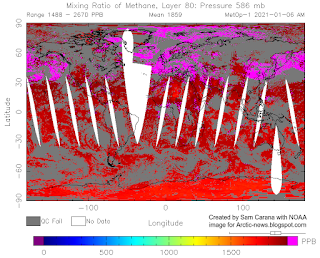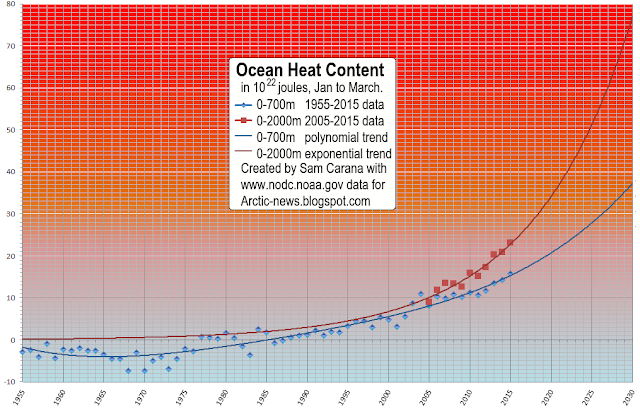The image below featured in an earlier post and was created with an image from the NASA website while using an 1885-1915 base, illustrating the calculation behind this 0.99°C. More details are here.
The image below from Copernicus illustrates that, for more than 14 consecutive months, the temperature anomaly has been high, i.e. about 0.8°C (± 0.3°C) above the 1991-2020 average and much more when compared to a pre-industrial base, with little or no sign of a return to earlier temperatures.
The image below, from an earlier post and created with an image from the NASA website while using a 1903-1924 base, confirms that the monthly temperature anomaly through August 2024 has been more than 1.5°C above this base for each of the past consecutive 14 months. The post adds that anomalies will be even higher when compared to a pre-industrial base. The red line shows a trend produced by the NASA website (2-year Lowess Smoothing).
The black dashed line in the image below, adapted from NOAA, indicates a transition to La Niña in October 2024, persisting through Jan-Mar 2025.
The image below, adapted from NOAA, illustrates that El Niño conditions were present from June 2023 through April 2024, and that ENSO-neutral started in May 2024.
While El Niños typically occur every 3 to 5 years, as NOAA explains, El Niños can occur as frequently as every two years, as happened in 2002, 2004 and 2006, as the above image shows. Moving from the bottom of a La Niña to the peak of a strong El Niño could make a difference of more than 0.5°C.
The danger is that we could move into a new El Niño in 2025, while temperatures remain high due to feedbacks and while sunspots move toward a peak in this cycle, expected to occur in July 2025.
The image below (top part), adapted from NOAA, shows the observed values for the number of sunspots for cycle 25, through August 2024, as well as the values predicted by NOAA (red line).
 |
| [ from earlier post, click on images to enlarge ] |
The above image (bottom part) shows the observed values for the F10.7cm radio flux for cycle 25, through August 2024, as well as the values predicted by NOAA (red line).
The observed values are much higher than predicted. If this trend continues, the rise in sunspots forcing from early 2020 to July 2025 may well make a difference of more than 0.25°C.
This - in combination with further events, developments and short-term variables - could constitute a cataclysmic alignment that could result in runaway temperature rise by 2026, as an earlier post concluded.
Natural variability is mentioned by the IPCC, but because such events vary from year to year, their impact is smoothed out in climate change calculations that average the temperature rise over the course of decades. Yet, when such events coincide in a cataclysmic alignment, as could be the case within the next few years, the extra rise in temperature from - say - the year 2021 could be over 0.75°C. Note that this is an extra rise, on top of the long-term rise due to activities by people since pre-industrial.
Furthermore, as emissions and temperatures keep rising, such an extra rise could trigger feedbacks that threaten to grow in strength and strike with ever greater ferocity, further accelerating the temperature rise while extreme weather disasters hit numerous regions around the world more frequently over larger areas, with greater intensity and for longer periods.
Such feedbacks include loss of sea ice and permafrost degradation, both terrestrial and on the seafloor of the Arctic Ocean, which looks set to cause huge releases of greenhouse gases. Temperature anomalies are high and Arctic sea ice volume is very low, as illustrated by the compilation of images below, adapted from nullschool, Climate Reanalyzer and the Danish Meteorological Institute.
Ominously, high methane concentrations (well over 2400 ppb) were recently recorded at the observatory in Utqiagvik (Barrow), Alaska, as illustrated by the image below, adapted from NOAA.
Climate Emergency Declaration
The situation is dire and the precautionary principle calls for rapid, comprehensive and effective action to reduce the damage and to improve the situation, as described in this 2022 post, where needed in combination with a Climate Emergency Declaration, as discussed at this group.
Links
• Water Vapor Feedback
https://arctic-news.blogspot.com/2024/09/water-vapor-feedback.html
• NOAA - Monthly Temperature Anomalies Versus El Niño
https://www.ncei.noaa.gov/access/monitoring/monthly-report/global/202408/supplemental/page-4
• NOAA - El Niño and La Niña
Slowing down of ocean currents could cause less heat to move deep into the ocean and more heat to instead accumulate at the surface, while more water vapor would enter the atmosphere, further speeding up the temperature rise, as discussed in earlier posts such as this one and as illustrated by the image below, created with NOAA data.
The compilation image below, with forecasts for September 20, 2024 03 UTC (run 00 UTC) adapted from Copernicus, illustrates gases and biomass-burning aerosols released due to forest fires burning in the Amazon. Formaldehyde and carbon monoxide cause hydroxyl depletion and thus extend methane's lifetime.
Conflict and socio-economic stress could add further forcing. Heatwaves, fires, famine, drought, floods, crop loss, loss of habitable land and corrupt politicians threaten to cause violent conflicts to erupt around the world, industrial activity to grind to a halt and the temperature to rise above 3°C from pre-industrial, driving humans into extinction. Sadly, politicians and mainstream media fail to inform people about the danger, and once the full horror reveals itself, panic could be added to the problems the world faces.
Dangers associated with high temperatures are discussed in this earlier post. A 2018 study (by Strona & Bradshaw) indicates that most life on Earth will disappear with a 5°C rise. Humans, who depend for their survival on many other species, will likely go extinct with a 3°C rise, as illustrated by the image below, from an earlier post.
The situation is dire and the precautionary principle calls for rapid, comprehensive and effective action to reduce the damage and to improve the situation, as described in this 2022 post, where needed in combination with a Climate Emergency Declaration, as discussed at this group.
Links
• NASA - Gistemp
https://data.giss.nasa.gov/gistemp
• Pre-industrial
https://arctic-news.blogspot.com/p/pre-industrial.html
• Did the climate experience a Regime Change in 2023?
https://data.giss.nasa.gov/gistemp
• Pre-industrial
https://arctic-news.blogspot.com/p/pre-industrial.html
• Did the climate experience a Regime Change in 2023?
• Water Vapor Feedback
https://arctic-news.blogspot.com/2024/09/water-vapor-feedback.html
• NOAA - Monthly Temperature Anomalies Versus El Niño
https://www.ncei.noaa.gov/access/monitoring/monthly-report/global/202408/supplemental/page-4
• NOAA - El Niño and La Niña
• Sunspots
https://arctic-news.blogspot.com/p/sunspots.html
• Cataclysmic Alignment threatens Climate Catastrophe
https://arctic-news.blogspot.com/p/sunspots.html
• Cataclysmic Alignment threatens Climate Catastrophe
https://arctic-news.blogspot.com/2024/09/cataclysmic-alignment-threatens-climate-catastrophe.html
• Feedbacks
https://arctic-news.blogspot.com/p/feedbacks.html
• NOAA - Global Monitoring Laboratory - Carbon Cycle Gases
https://gml.noaa.gov/dv/iadv/graph.php?code=BRW&program=ccgg&type=ts
• Nullschool
https://earth.nullschool.net
• Climate Reanalyzer
https://climatereanalyzer.org
• Danish Meteorological Institute - Arctic sea ice volume and thickness
https://ocean.dmi.dk/arctic/icethickness/thk.uk.php
• Copernicus - pulse
https://pulse.climate.copernicus.eu
• Copernicus - atmosphere
• Feedbacks
https://arctic-news.blogspot.com/p/feedbacks.html
• NOAA - Global Monitoring Laboratory - Carbon Cycle Gases
https://gml.noaa.gov/dv/iadv/graph.php?code=BRW&program=ccgg&type=ts
• Nullschool
https://earth.nullschool.net
• Climate Reanalyzer
https://climatereanalyzer.org
• Danish Meteorological Institute - Arctic sea ice volume and thickness
https://ocean.dmi.dk/arctic/icethickness/thk.uk.php
• Copernicus - pulse
https://pulse.climate.copernicus.eu
• Copernicus - atmosphere
https://atmosphere.copernicus.eu/charts/packages/cams
• Water Vapor feedback
https://arctic-news.blogspot.com/2024/09/water-vapor-feedback.html
• High feels like temperature forecast
https://arctic-news.blogspot.com/2024/08/high-feels-like-temperature-forecast.html
• When will we die?
https://arctic-news.blogspot.com/2019/06/when-will-we-die.html
• Water Vapor feedback
https://arctic-news.blogspot.com/2024/09/water-vapor-feedback.html
• High feels like temperature forecast
https://arctic-news.blogspot.com/2024/08/high-feels-like-temperature-forecast.html
• When will we die?
https://arctic-news.blogspot.com/2019/06/when-will-we-die.html
• Transforming Society
https://arctic-news.blogspot.com/2022/10/transforming-society.html
• Climate Plan
https://arctic-news.blogspot.com/p/climateplan.html
• Climate Emergency Declaration
https://arctic-news.blogspot.com/p/climate-emergency-declaration.html
https://arctic-news.blogspot.com/2022/10/transforming-society.html
• Climate Plan
https://arctic-news.blogspot.com/p/climateplan.html
• Climate Emergency Declaration
https://arctic-news.blogspot.com/p/climate-emergency-declaration.html
























![[ click on images to enlarge ]](https://blogger.googleusercontent.com/img/b/R29vZ2xl/AVvXsEjBULCiq_2Euddl4zoTQ29dVdWCHG5ubjXQ3e8BMvWAbzOr8KIa8vFDh93RkPCtxgr0tpVNjvH5lTvVVQ-6u8Bbww3gXVitUgmhcvvg8cpujuD_fhE9Tqt8nLvJ3UjYZtEntWhyphenhyphenTPhhpCs/w640-h272/August-2020-NH-OTA-narrow.png)

























